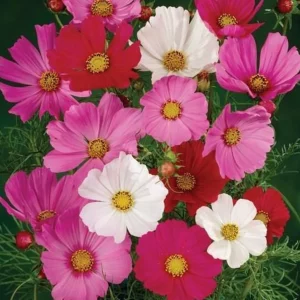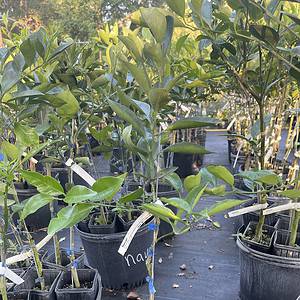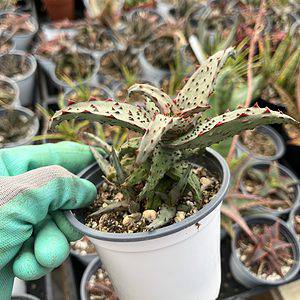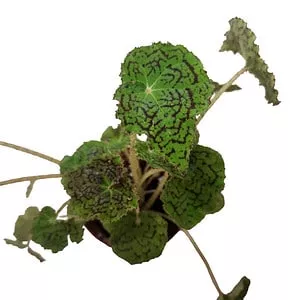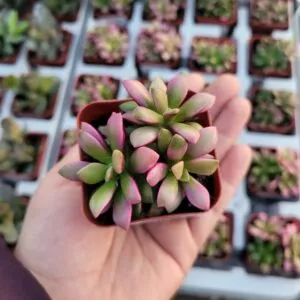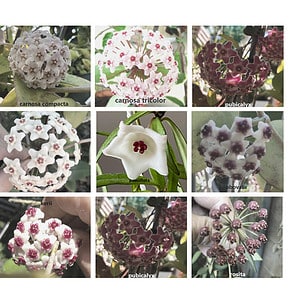No products in the cart.
Table of Contents
Maybe you have come across the plant named Sedum at your horticulture store. These plant species vary so much, and you might be wondering if they are related. The plant grows tall with a bush-like appearance. They are a type of herbaceous succulent that can be found in North and South America.
You may find them with star-shaped flowers with a spiral or perhaps a rose-shaped leaf creeping like a vine. So, yes, there are more than 470 different species. But many of them have some things in common.
Today, we will provide you with helpful information to ensure your ground cover plant remains in tip-top condition.
What is Plant Sedum?
You can find many Sedum varieties in this large genus of flowering plants. You find Sedum plants in different colors, forms, and heights on every continent.
The Sedum plants are also known as stonecrop and are drought tolerant to cold hardy with thick stems and succulent leaves.
Typically they have small flowers blooming in late summer, and the genus is divided into two groups. Low-growing Sedums thrive as ground cover; the other perennials are upright Sedum plants.
Creeping Sedums remain short, a few inches tall, and spread, while upright ones form beautiful vertical clumps along flower beds and borders. The best time to plant Sedums is in spring after the dangers of frost pass.
Sedum Plant Care

The Sedum spp looks excellent throughout the growing season as they have exciting foliage with spectacular flowers for mass planting, edging, ground covers, containers, and rock gardens. Sedums bloom in early summer and have long-lasting cut flowers attracting pollinators like butterflies to the garden.
The best part is they are low maintenance in a garden or growing as indoor plants. Plant Sedum in a spot with good drainage and rich soil in enough light, and they care for themselves. You need not deadhead the spent blooms; they look fabulous in winter.
While they can tolerate partial shade, lacking sunlight can result in leggy growth. Thus, it helps to cut your Sedum back after flowering to maintain a great shape and encourage bushier growth.
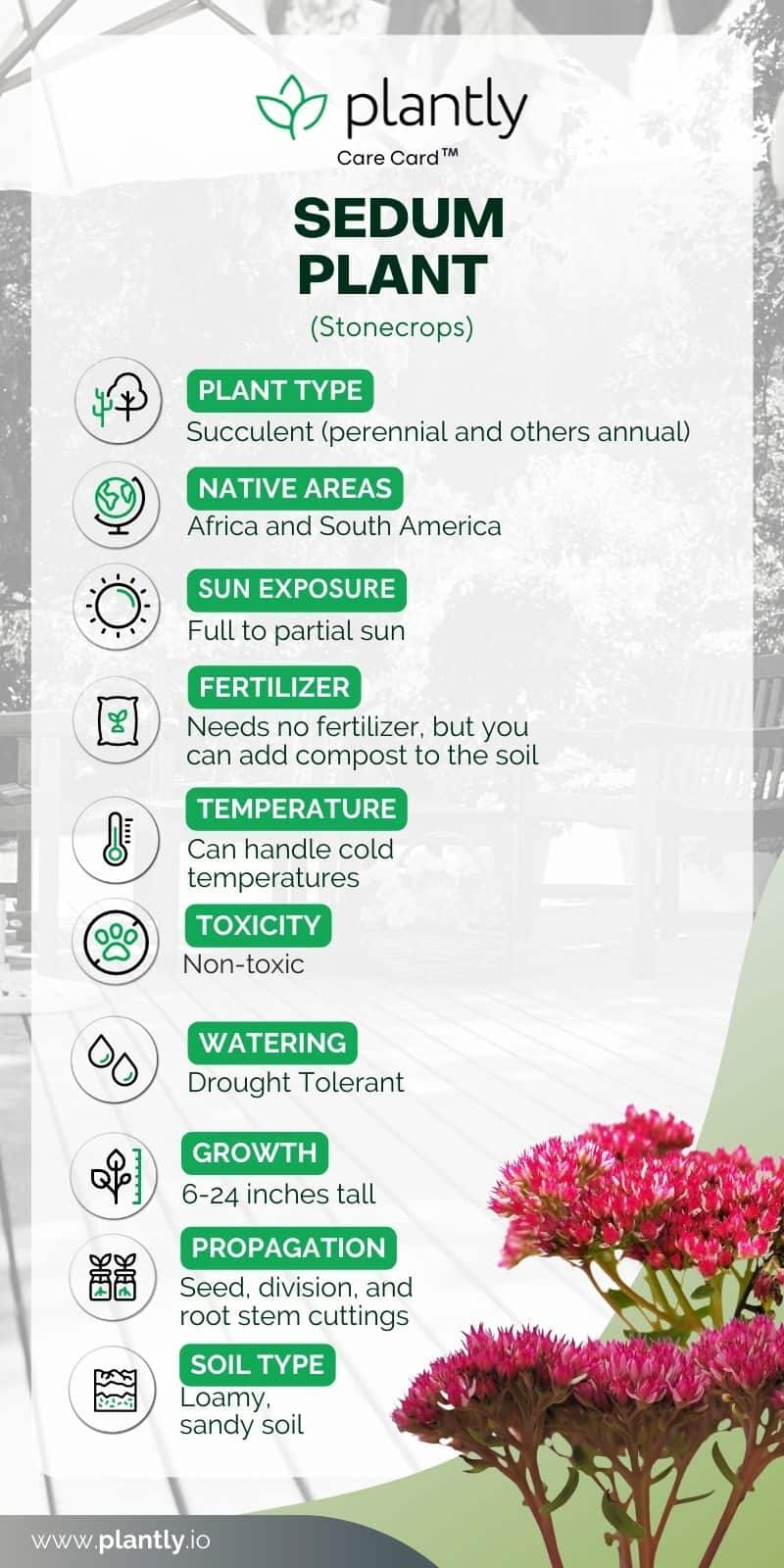
Best Soil For Sedums
Okay, we know that most plants need nutrient-filled soil. But growing Sedum is different as it loves rocky, sandy soil. Sometimes, it can even grow without soil on rocks and trees. The only time it grows roots is when it touches a surface.
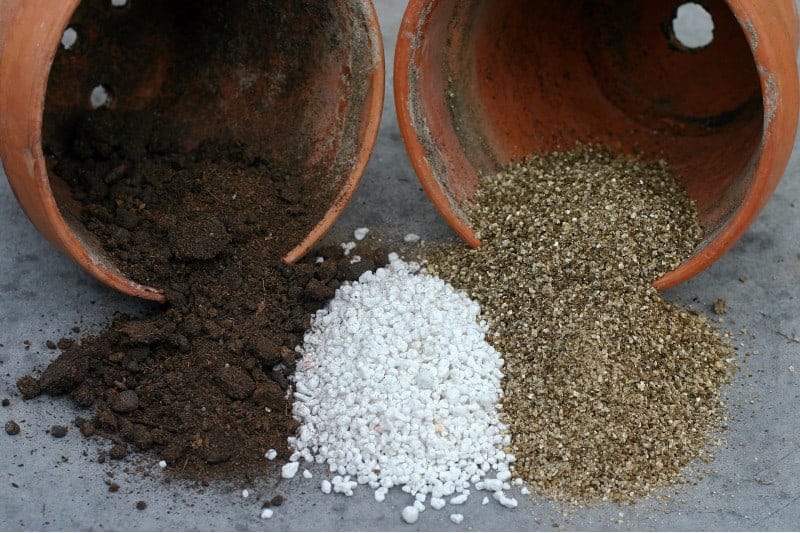
You can grow them with other plants needing compost but do not fertilize them. Another crucial thing is always to use well-drained soil. No need to invest in the expensive potting mix as sand and gravel work well. That’s great news, huh? So, remember well-drained soil to prevent root rot.
Light For The Star Shaped Flowers
When you do mass plantings of Sedums, you’ll find that some grow in full sun while others do well in partial shade. If you treat them as an indoor plant, place them near a north-facing window that can get adequate light to supply them during the entire day.
But the succulent does well in the full sun compared to the creeping varieties. So when grown outside or as container plants, they need at least six hours of direct sunlight. If you live in a hot or dry environment, provide most Sedums some afternoon shade to prevent scorching.
Watering Your Sedums
If you received your Sedum plant recently, you can water it once a week to prevent a complete dry out of the ground. Once your succulent is in the raised beds, it does not need much watering. But if you find the temperature is hot and rainfall is deficient, we recommend giving them some water.
Your plant is drought tolerant to an extent, as the succulent leaves can hold enough water to thrive. But once depleted, your Sedum will start shrinking. Established plants are more drought-tolerant than young plants.
Temperature and Humidity
When it comes to many gardens, the growing zones for your Sedum vary. Yet, in general, your plant can tolerate different temperatures. Just make sure the temperature is not above 90°F (32oC)as it might scorch the delicate leaves.

Further, whether you have black-eyed Susans or other succulents, they can tolerate humidity.
Fertilizing Sedum Plants
Compared to most plants, your Sedum is not a feeder and tolerates poor soil well. So if you have a too-rich potting mix, it can grow leggy. Adding compost to the soil mix is allowed, but no slow-release fertilizer is used.
How to Propagate Sedum Plants
Each plant can be propagated in different ways, depending on your species. For example, you can collect the seed in mid-spring for a low-growing Sedum used as ground cover. You can also use root stem cuttings during summer.
You’ll find the seeds of the flowers are tiny and need spacing correctly, depending on the variety you have. Digging a hole is unnecessary; you can press the seed into the ground. Neither does it need covering with added soil. The best time is in the fall, which allows the roots to settle.
To collect the seed, you must get it from the drying flower and leave it indoors to dry further. Once dry, you can shake it on paper to collect the seeds. Then, plant them in a moist yet sandy medium while keeping them misted until you see growth.
You can transplant them after a year, but most gardeners use the division with the cutting method.
-
Free Shipping$39.97Sold By: Grow Your Own Food Nursery
In stock
River Tamarind Miracle Tree Plant
Sold By: Grow Your Own Food Nursery -
Free Shipping$7.99 – $14.29Sold By: CZ Grain
In stock
Cosmos Flower Seeds, Sensation Mix Color Seeds – Non-GMO Seeds – Ships from Iowa, USA
Rated 4.60 out of 5 based on 156 customer ratings00Sold By: CZ Grain -
$70.00Sold By: Andy Nursery
$75.00In stock
Navel Orange Grafted Citrus Tree. 3 Feet Tall. Free Shipping
Sold By: Andy Nursery -
$26.99Sold By: Cacti and Exotica
In stock
4″ Aloe castilloniae
Rated 4.98 out of 5 based on 59 customer ratings00Sold By: Cacti and Exotica
Division and Cutting Propagation
If propagation on your cultivar is not prohibited, you can use stem cuttings or division.
STEM CUTTINGS
Use clean pruners to take a stem cutting of six inches from a healthy stem.
Remove the bottom leaves, leaving some growth at the top.
Fill a small pot with a soilless mix and place the cutting.
Moisten well and keep it moist.
After a few weeks, you will see new growth and can care for it as all your other perennials in the Sedum spp.
DIVISION
The division method works well on mature plants as they can start to die at the center and leave a hole. The best time to do this is in spring when you notice new growth.
For large clumps, water them well before you divide them. It will make lifting out the root ball easier.
Lift out the entire root ball using a spade and then separate them into sections using a trowel.
Replant your sections in a new location and keep them at the same depth as your parent plant.
Water well at all times until you see new growth.
USDA Growth Zone
As there are different species, the best is to find one that will grow in your environment. The hardiness zones are from 3 to 10 for growing your Sedum outside. The important thing is that it must not receive too much water.
Potting and Pruning
Whether you have a creeping or tall stone crop, they both work well in containers. The important thing is to provide it with soil that drains well to prevent root rot. You can even prune your Sedums when they become busier during spring growth.
You can cut the stems back an inch in early spring. But you can pinch off some of the new development near the ground to create a compact branch with thick growth.
Sedum Varieties and Similar Plants
As there are so many varieties, some are more popular than others. Some are classified as upright Sedum while others are creeping ones. Here are some of them:
Sedum morganianum
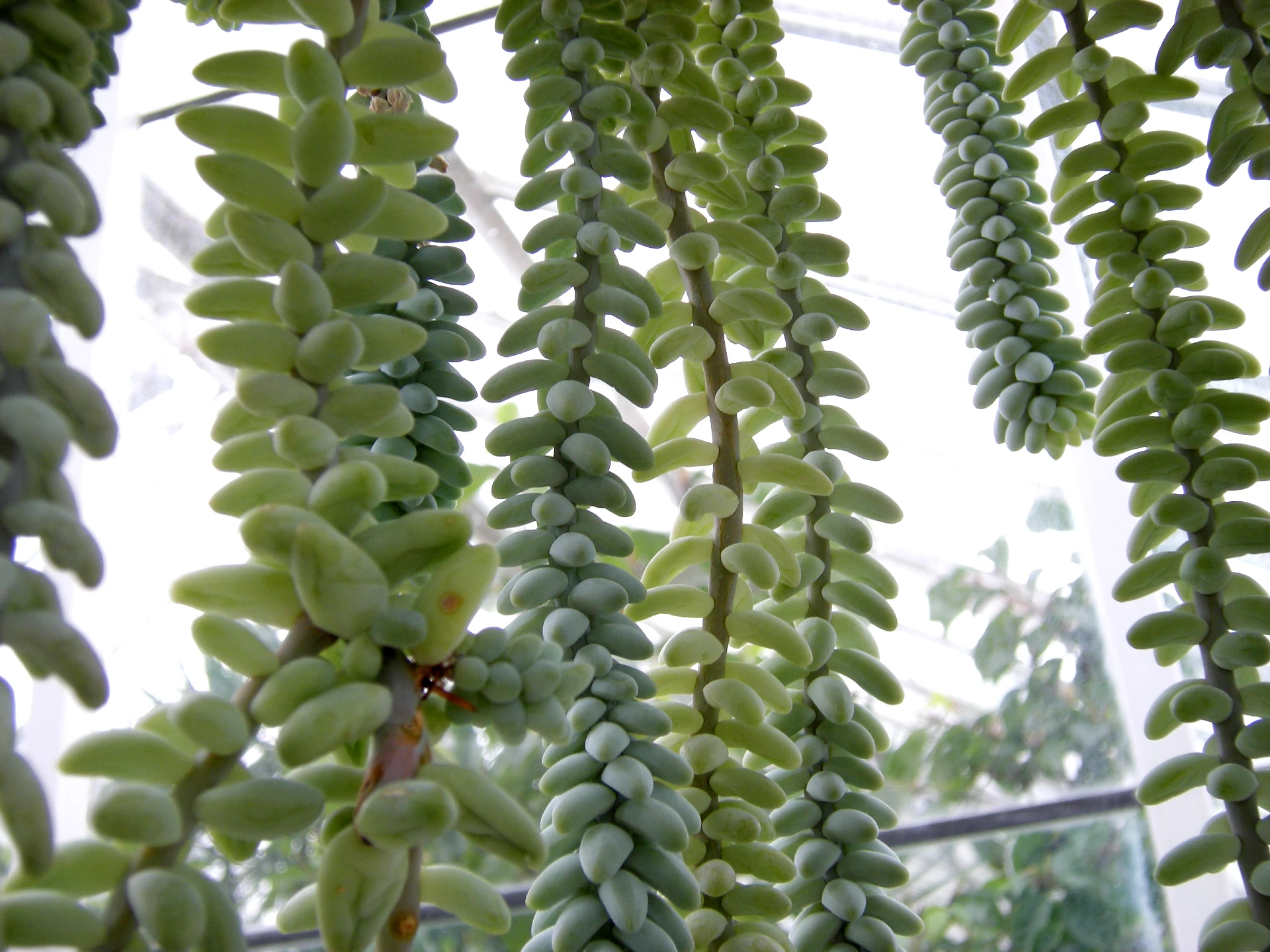
The burro’s tail or donkey tail flowers stand on bright yellow stamens with light pink sepals. The small yellow flowers attract pollinators to the garden.
Sedum adolphii
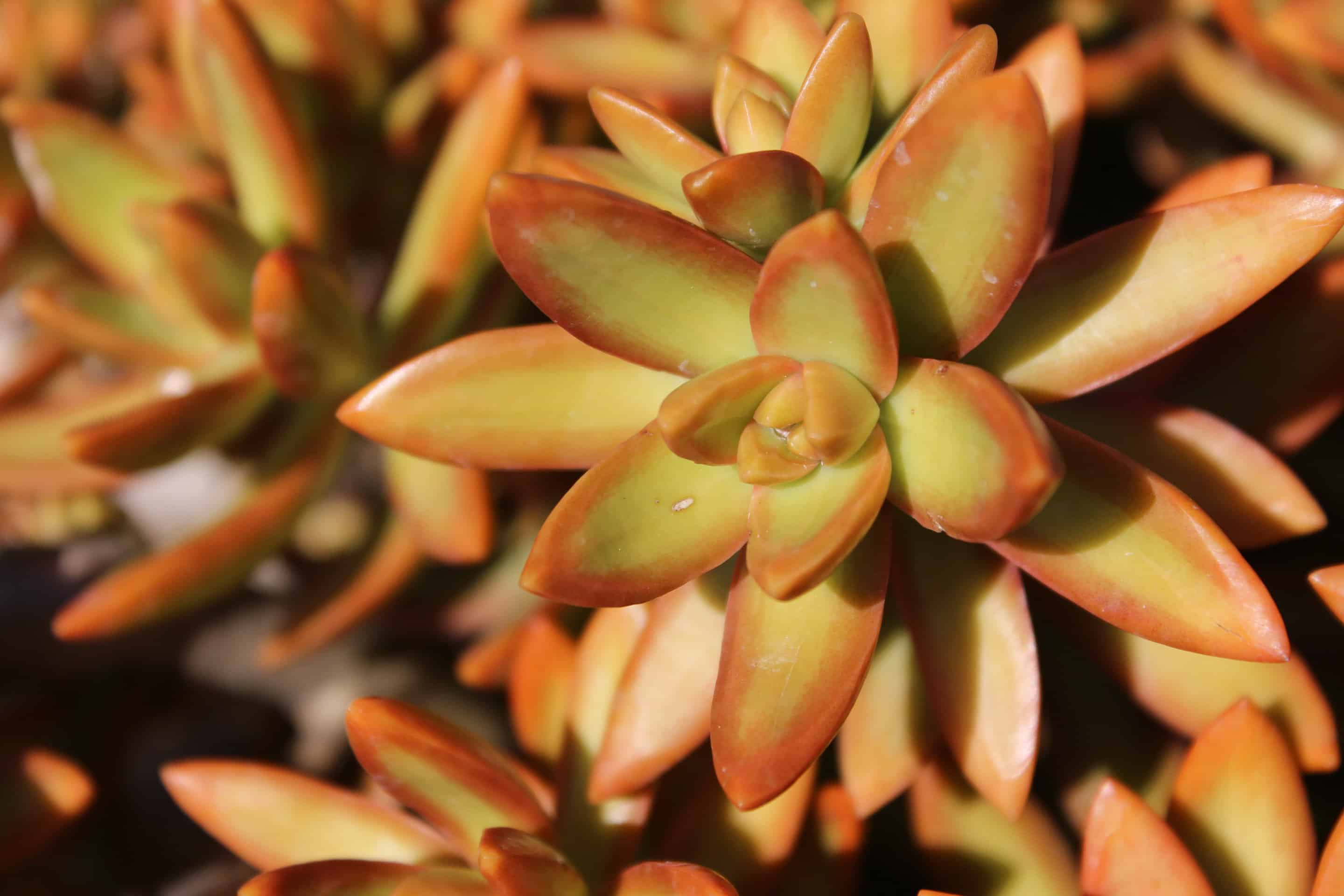
The creeping sedum forms golden miniature rosettes, and the leaves look shaped like footballs. The leaf tip is red when exposed to direct sunlight.
Sedum “Dragon’s Blood”
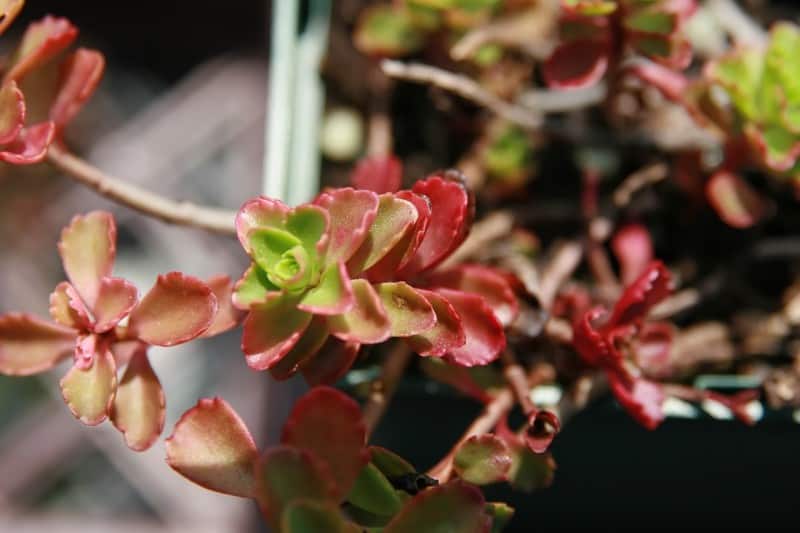
This is a creeper with a dark purple color. Yet, when late summer arrives, you see it blooming pinkish-purple flowers. While the Sedum flowers mentioned are mostly creeping sedums, you can also find taller varieties to grow Sedums.
Sedum Diseases & Pests
You will love that your plant does not have many problems. The biggest concern is over-watering your plant. Do not let your plant get too much moisture, as the root stem might start to rot. If you find one of the stems is affected, the best is to remove it and stop watering it.
Leave the ground to dry out to save your plant. Another concern is fungi caused by excessive moisture; you’ll notice the leaves withering or turning yellow. To rescue your Sedum remove the sick parts and provide the soil with proper drainage.
Frequently Asked Questions
Here, it all depends on the type of variety you have. Your creeping Sedum plants grow low to the ground and spread slowly in sunny areas. They are ideal for growing containers on walls and draping over rocks and sidewalks.
The Sedum varieties are perennial, but some are frost-tender to grow annually as they will not survive freezing temperatures.
None of the Sedum plants are known to be toxic to humans or pets.
Sedum varieties are succulents that store water in the roots, stems, and fleshy leaves.
The lack of blooms can be too little sunlight or watering too much. While you can grow Sedum in the shade, it still needs full sun to bloom. Also, check the soil to determine if it needs watering.
You need not overwinter a Sedum like the Autumn Joy and can trim away the damaged foliage after a freeze or leave them intact for the winter.
Whether you want to buy, sell or simply reach out to other plant enthusiasts, Plantly is the right place to be!
-
$12.00Sold By: PotHedz Plants
In stock
Begonia Decko Checks
Rated 4.96 out of 5 based on 106 customer ratings00Sold By: PotHedz Plants -
$4.99Sold By: Plants by Stinky Boo
In stock
Anacampseros ‘Sunrise’ Succulent
Rated 5.00 out of 5 based on 2 customer ratings00Sold By: Plants by Stinky Boo -
Free Shipping$22.99Sold By: Gar-Zen Botanical Design
In stock (can be backordered)
Petra Croton Ships Free
Rated 4.86 out of 5 based on 49 customer ratings02Sold By: Gar-Zen Botanical Design -
$14.00 – $18.00Sold By: Beauties & Beasts
Hoya House Plant various species
Rated 4.83 out of 5 based on 24 customer ratings00Sold By: Beauties & Beasts

